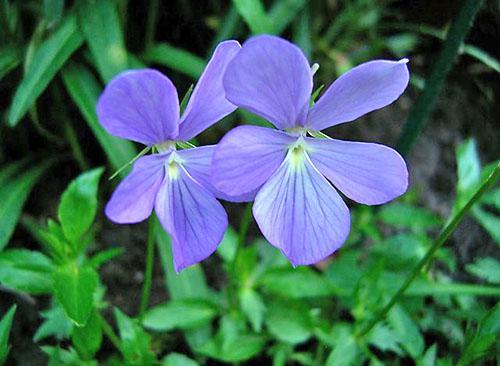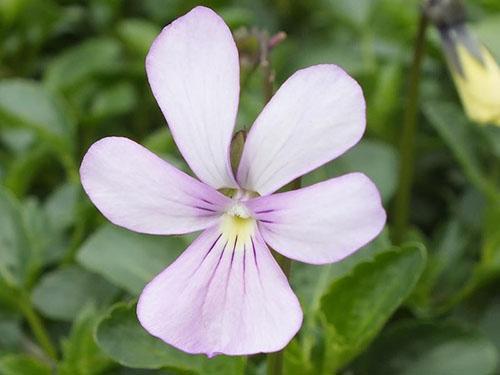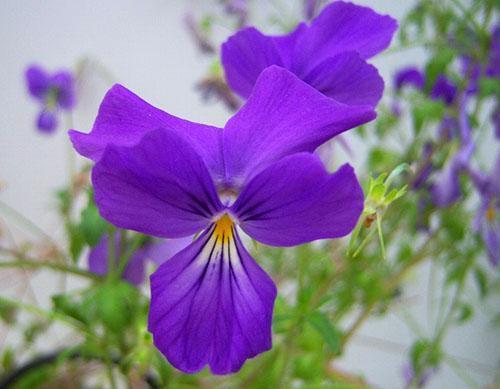Choosing a perennial plant for the balcony and garden horned violet
 If you look at the flower of the horned violet from the side of the peduncle, a sharp protruding spur resembling a horn is clearly visible. It is thanks to this feature that the plant got its name, which sounds like Viola cornuta in Latin.
If you look at the flower of the horned violet from the side of the peduncle, a sharp protruding spur resembling a horn is clearly visible. It is thanks to this feature that the plant got its name, which sounds like Viola cornuta in Latin.
Horned violet: features of the species

Gardeners note that the flowering of the horned violet begins when the snow has not yet melted in the shady corners, which indicates that the species belongs to a large group of decorative perennials grown in Russian gardens. The peak of flowering occurs in the first half of summer, then the appearance of new buds subsides somewhat, but does not stop. The last flowers of the horned violet wither only with the onset of frost by mid-autumn.
Wild plants of this species reveal corollas of white, blue, lilac and purple tones. When grown for a long time in one place, the violet forms dense sods from intertwining creeping stems.
You can distinguish a perennial horned violet by its rich green ovoid leaves with a pointed tip.
In wild plants, flowers with simple petals are not too large. Their corollas do not exceed 2–4 cm in diameter, but thanks to the interest in the species of breeders, today flower growers have at their disposal many large-flowered varieties and hybrids of various colors.
How to grow a perennial horned violet?
 The plant feels great in the middle lane, and in one place it can grow up to 5 years, creating bright decorative spots in the garden that decorate the site throughout the warm period. Therefore, in order to grow perennial horned violets, a gardener who is interested in this crop does not have to create any special conditions.
The plant feels great in the middle lane, and in one place it can grow up to 5 years, creating bright decorative spots in the garden that decorate the site throughout the warm period. Therefore, in order to grow perennial horned violets, a gardener who is interested in this crop does not have to create any special conditions.
When choosing a place suitable for planting violets, it is best to pay attention to well-lit corners, but hidden from the direct rays of the sun. If you plant a horned violet in the scorching heat, growth slows down, the plant often suffers from dry soil. In the thick shade, the violet stretches out, the flowers become smaller, but the foliage grows very actively.
Horned violets perfectly acclimatize in the shade of other plants, for example, under ornamental shrubs and tree crowns. In this case, in the spring, nothing prevents the flowers from developing, and in the summer the violets are sheltered from the hot sun.
Delicate flowers feel great next to honeysuckle, barberry... Horned violets thrive and bloom remarkably in light drained soils with pH 6.8-7.2. Since the plant is very unpretentious, it is not afraid of small flooding in the spring, but drying of the soil and long periods of drought can negatively affect the health of the violet.
Violet care at home and in the garden
 The main care of violets during the growing season is regular watering, removing weeds and feeding the formed clumps.
The main care of violets during the growing season is regular watering, removing weeds and feeding the formed clumps.
The drier and hotter the summer, the more water the plants should receive, and during a drought, violets can be sprayed early in the morning and after sunset.Such a measure will help freshen the plantings, but will not cause sunburn.
 During active flowering, the horned violet requires weekly feeding. Fertilization is alternated with watering or fertilizing agents are mixed with irrigation moisture. Organic violets are regularly fed in the spring, then in the middle of summer. In the second half of August, the application of nitrogen-containing fertilizers is limited.
During active flowering, the horned violet requires weekly feeding. Fertilization is alternated with watering or fertilizing agents are mixed with irrigation moisture. Organic violets are regularly fed in the spring, then in the middle of summer. In the second half of August, the application of nitrogen-containing fertilizers is limited.
To reduce the number of weeds and reduce moisture evaporation, the areas around the curtains and on the hills, where perennial horned violets are often grown, are covered with expanded clay, chips or gravel, spread with moss or planted with stonecrops.
Caring for violets at home and in the garden must include pruning wilted flower stalks, cleaning old foliage, other measures to maintain the appearance of plantings and stimulate lush flowering. So, for example, experienced flower growers advise every three years to plant young violets on existing plants. In this case, an imperceptible gradual change of generations occurs, and the curtain constantly remains even and abundantly blooming.
 Do not forget that under favorable conditions horned violets can produce seeds that are independently sown from the fruit-boxes. The seeds sprout in the spring, and the next year the young violets are ready to bloom.
Do not forget that under favorable conditions horned violets can produce seeds that are independently sown from the fruit-boxes. The seeds sprout in the spring, and the next year the young violets are ready to bloom.
Newly planted plants in the first winter can be covered with needles or another type of mulch, and adult violets in the middle lane winter well and without loss outside the shelters.
Reproduction of violets at home and on a personal plot
 For reproduction of horned violets, sowing of seeds or division of an already existing adult bush is most often used.
For reproduction of horned violets, sowing of seeds or division of an already existing adult bush is most often used.
The seeds are planted in seedling boxes with a light soil mixture in the spring, in April, or in the fall, in October. You can wait for shoots in 4–5 weeks. When a pair of real leaves appear, the violets dive and plant in separate pots. To grow perennial horned violets on a balcony or flowerpot, young plants are planted in prepared containers with a drainage layer and loose nutrient soil.
Violets that have developed at home are transferred to the garden at the end of summer, so that the plants have time to acclimatize before the onset of cold weather. Strong rosettes begin to bloom already in the first year, and the mass appearance of buds should be expected after wintering.
 In addition to propagation by seeds, dividing the bush is often used, and rooting of green cuttings and parts of the stem is also used to obtain new plants. Cuttings can be obtained during the entire growing season, while early cuttings and rooting contribute to the rapid entry of violets into the flowering season. The unpretentious horned violets easily, after 2-3 weeks, form roots and form new plants, which accelerates reproduction and allows you to quickly get healthy flowering specimens.
In addition to propagation by seeds, dividing the bush is often used, and rooting of green cuttings and parts of the stem is also used to obtain new plants. Cuttings can be obtained during the entire growing season, while early cuttings and rooting contribute to the rapid entry of violets into the flowering season. The unpretentious horned violets easily, after 2-3 weeks, form roots and form new plants, which accelerates reproduction and allows you to quickly get healthy flowering specimens.
To obtain a dense, beautiful violet meadow per square meter, depending on the variety, from 20 to 30 plants are planted.
Horned violet in the decoration of the garden and balcony
 The rather small flowers of the horned violet look spectacular only with mass flowering. Therefore, a small ornamental culture is used in group plantings, where one or more varieties of violets are used. Plants look great against the background of rose bushes, next to low conifers and other plants in the garden.
The rather small flowers of the horned violet look spectacular only with mass flowering. Therefore, a small ornamental culture is used in group plantings, where one or more varieties of violets are used. Plants look great against the background of rose bushes, next to low conifers and other plants in the garden.
Horned violets in the garden are planted as curbs and on slides. Do not forget that at home the violet grows well in flowerpots and balcony boxes. Only in this case, you will have to pay more attention to feeding, watering and caring for the plants, otherwise the violets will quickly lose their decorative effect and stop blooming.